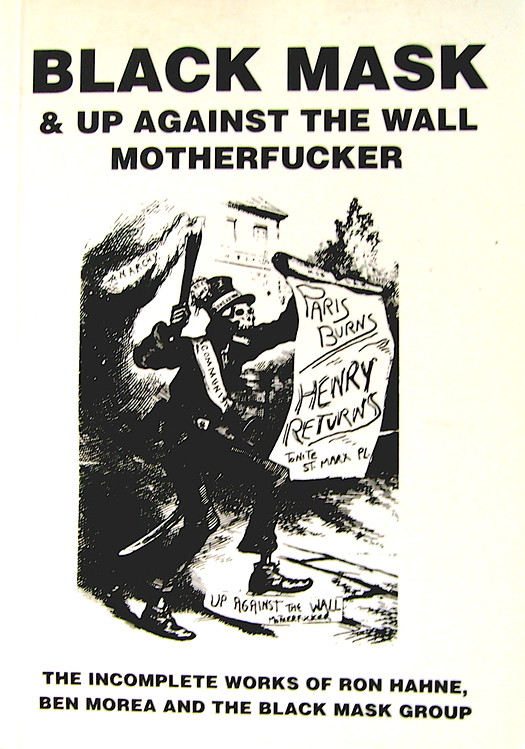Black Mask & Up Against the Wall Motherfucker: The Incomplete Works of Ron Hahne, Ben Morea, and the Black Mask Group (1993)
Filed under book | Tags: · 1960s, anarchism, art, new york, politics

Founded in New York City in the mid-1960s by self-educated ghetto kid and painter Ben Morea, the Black Mask group melded the ideas and inspiration of Dada and the Surrealists, with the anarchism of the Durruti Column from the Spanish Revolution. With a theory and practice that had much in common with their contemporaries the San Francisco Diggers, Dutch Provos, and the French Situationists—who famously excommunicated 3 of the 4 members of the British section of the Situationist International for associating too closely with Black Mask—the group intervened spectacularly in the art, politics and culture of their times. From shutting down the Museum of Modern Art to protesting Wall Street’s bankrolling of war, from battling with Maoists at SDS conferences to defending the Valerie Solanas shooting of Andy Warhol, Black Mask successfully straddled the counterculture and politics of the 60s, and remained the Joker in the pack of both sides of “The Movement.”
By 1968 Black Mask dissolved into “The Family” (popularly known as Up Against The Wall Motherfucker—the name to which they signed their first leaflet), which combined the confrontational theater and tactics of Black Mask with a much more aggressively “street” approach in dealing with the police, and authorities. Dubbed a “street gang with analysis” they were reputedly the only white grouping taken seriously by the Black Panther Party, and influenced everyone from the Weathermen to the “hippy” communal movements.
This volume collects the complete ten issues of the paper Black Mask (produced from 1966-1967 by Ben Morea and Ron Hahne), together with a generous collection of the leaflets, articles, and flyers generated by Black Mask, and UATW/MF, the UATW/MF Magazine, and both the Free Press and Rolling Stone reports on UATW/MF.
By Ben Morea and Ron Hahne
Edited by Jacques Vache Editorial Group, London, UK
Anticopyrighted under the Berne, Baby, Berne convention; any portion maybe produced by any means necessary, as permitted under the Copy-Cat Riot Actions, 1981, 1985, and 1990
ISBN 1873176708
140 pages
via Self Learn Los Angeles
wikipedia
publisher (2011 edition)
google books (2011 edition)
PDF (no OCR)
Comments (3)Tom Wolfe: Radical Chic & Mau-Mauing the Flak Catchers (1970)
Filed under book | Tags: · art, history, journalism, politics, race, united states

Radical Chic and Mau-Mauing the Flak Catchers, Tom Wolfe’s fourth book of social commentary, consists of two devastatingly funny essays, closely related in theme and substance, dealing with political stances and social styles in a status-minded world. In “Radical Chic,” Wolfe describes an intriguing phenomenon of the late Sixties: the courting of romantic radicals-Black Panthers, striking grapeworkers, Young Lords-by New York’s socially elite. He focuses primarily on one symbolic event: the gathering of the radically chic at Leonard Bernstein’s duplex apartment on Park Avenue to meet spokesmen of the Black Panther Party, to hear them out, and to talk over ways of aiding their cause. Tom Wolfe re-creates the incongruous scene-and its astonishing repercussions-with high fidelity. But he gives us more than just a wry account of life among the Beautiful People; he also provides a historical perspective on that impulse of the upper classes to identify themselves with what they imagine to be the raw, vital lifestyle of the lower orders.
In the companion essay, Wolfe travels west to San Francisco to survey another meeting ground between militant minorities and the liberal white establishment: the newly emerging art of confrontation developed by young blacks, Chicanos, Filipinos, Chinese, Indians, and Samoans in response to the bureaucracy that grew up in and around the poverty program. Wolfe’s account of the performances of such masters as the Mission Rebels, the Youth for the Future, and the New Thang, and the responses of the catchers of the flak, including the Mayor himself, makes for uproarious farce. But the points he makes about racial and ethnic game-playing in America’s class wars are inescapably valid.
Radical Chic article first published in the Jun 8, 1970 issue of New York
Published by Farrar, Straus and Giroux, 1970
ISBN 9780312429133
commentary (Michael Bracewell, Frieze)
wikipedia
author
publisher (reissued by Picador, 2009)
PDF (no images, altered paging)
PDF (original article, incl. images)
View online (original article, HTML)
Jim Ellis: Derek Jarman’s Angelic Conversations (2009)
Filed under book | Tags: · activism, aesthetics, art, biography, film, politics, punk, situationists

Best known as an iconoclastic, wildly inventive filmmaker, Derek Jarman was also an accomplished author, painter, and landscape artist. In Derek Jarman’s Angelic Conversations, Jim Ellis considers Jarman’s wide-ranging oeuvre to present a broad perspective on the career and life of one of the most provocative, engaged, and important artists of the twentieth century.
Derek Jarman’s Angelic Conversations analyzes Jarman’s work—including his famous films Caravaggio, Jubilee, Edward II, Blue, and Sebastiane—in relation to his critiques of the government and his activism in the gay community, from the liberationist movement to the AIDS epidemic. While others have frequently focused on Jarman’s biography, Ellis looks at how his politics and aesthetics are intertwined to comprehend his most radical aspects, particularly in films such as War Requiem and The Last of England.
Here Jarman is revealed as an artist who keenly understood the role of history and mythology in creating a personal and national identity: as an activist, he sought to challenge old histories while producing new ones to carve out a space for alternative communities in Britain late in the twentieth century.
Publisher University of Minnesota Press, 2009
ISBN 0816653135, 9780816653133
312 pages

